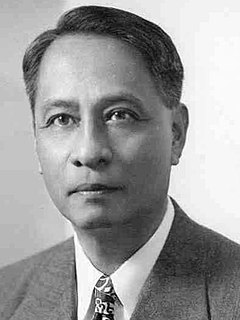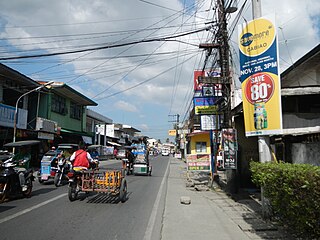Related Research Articles

Nueva Ecija is a landlocked province in the Philippines located in the Central Luzon region. Its capital is the city of Palayan. Nueva Ecija borders, from the south clockwise, Bulacan, Pampanga, Tarlac, Pangasinan, Nueva Vizcaya and Aurora. The province is nationally known as the Rice Granary of the Philippines, producing the largest rice yield in the country.

Manuel Acuña Roxas was the fifth President of the Philippines who served from 1946 until his death in 1948. He briefly served as the third and last President of the Commonwealth of the Philippines from May 28, 1946 to July 4, 1946 and then became the first President of the independent Third Philippine Republic after the United States ceded its sovereignty over the Philippines.

Luis Mangalus Taruc was a Filipino political figure and rebel during the agrarian unrest of the 1930s until the end of the Cold War. He was the leader of the Hukbalahap group between 1942 and 1950. His involvement with the movement came after his initiation to the problems of agrarian Filipinos when he was a student in the early 1930s. During World War II, Taruc led the Hukbalahap in guerrilla operations against the Japanese occupants of the Philippines.

The Hukbalahap, or Hukbong Laban sa Hapon, was a socialist/communist guerrilla movement formed by the farmers of Central Luzon. They are popularly known as the "Huks". They were originally formed to fight the Japanese, but extended their fight into a rebellion against the Philippine government, known as the Hukbalahap Rebellion, in 1946. It was put down through a series of reforms and military victories by the Philippines' Secretary of National Defense, and later President, Ramon Magsaysay.

Cabiao, officially the Municipality of Cabiao is a 1st class municipality in the province of Nueva Ecija, Philippines. According to the 2015 census, it has a population of 79,007 people. Cabiao is the 3rd most populous,one of the richest, and fastest growing municipality in the province, only behind Talavera and Guimba. If cities are included, the town ranks 7th.

The Communist Party of the Philippines is a revolutionary organization and communist party in the Philippines, formed by Jose Maria Sison on December 26, 1968. It is designated as a terrorist group by the United States Department of State through Executive Order No. 13224 together with Sison and the New People's Army (NPA) in 2002. The European Union, through Council Decision (CSFP) 2019/1341, renewed the terrorist designation of the CPP-NPA in 2019, though the European Union's second highest court ruled in September 2009 to delist Sison as a "person supporting terrorism" and reversed a decision by member governments to freeze assets. According to the US' Central Intelligence Agency (CIA) World Factbook, the CPP and its armed wing, the NPA, aims to destabilize the Philippines' economy and overthrow the national government.
The Partido Komunista ng Pilipinas-1930 (PKP-1930) is a communist party in the Philippines that was established on November 7, 1930. It uses the aforementioned appellation in order to distinguish itself from its better known splinter group, the Communist Party of the Philippines.
Crisanto Evangelista was a Filipino Communist politician and labor leader of the first half of the 20th century. He is credited as being one of the founders of the Partido Komunista ng Pilipinas. Evangelista was also an influential head of the Congreso Obrero de Filipinas, at the time the foremost and largest trade federation in the Philippines, having served as secretary for multiple years. He also headed the Union de Impresores de Filipinas as its Secretary-General. Prior to forming the PKP, Evangelista was a member of the Partido Obrero de Filipinas, a Filipino workers' party with increasingly radical leanings. Evangelista was eventually captured by the Japanese during the Second World War and executed.
The Democratic Alliance was a leftist party in the Philippines created on July 15, 1945, primarily composed of members of the National Peasants Union of the Hukbalahap, the Committee of Labor Organizations of the Communist Party of the Philippines, the Filipino Blue Eagle Guerrillas, and other organizations. The party supported and endorsed the bid of incumbent president Sergio Osmeña and the Nacionalista Party during the 1946 presidential elections against Manuel Roxas and the Nacionalista's liberal wing due to the latter's sympathetic attitude towards Filipino collaborators of the Japanese during World War II and close affiliation with "vested-interest landlord groups".

Pedro Abad Santos y Basco was a Filipino politician. He founded the Partido Sosyalista ng Pilipinas (PSP) or Philippine Socialist Party in 1929. He ran for several local elections but never won. Luis Taruc of the Hukbalahap Rebellion was under his tutelage and was his right-hand man.
The legislative districts of Nueva Ecija are the representations of the province of Nueva Ecija in the various national legislatures of the Philippines. The province is currently represented in the lower house of the Congress of the Philippines through its first, second, third, and fourth congressional districts.

Rafael "Ka Paeng" Vitriolo Mariano is a Filipino politician. He was a member of the House of Representatives for Anakpawis serving from 2004 to 2013. He is also the chairman of the farmers militant group Kilusang Magbubukid ng Pilipinas (KMP).

Lope K. Santos was a Filipino Tagalog-language writer and former senator of the Philippines. He is best known for his 1906 socialist novel, Banaag at Sikat and to his contributions for the development of Filipino grammar and Tagalog orthography.
The Hukbalahap Rebellion was a rebellion staged by former Hukbalahap or Hukbo ng Bayan Laban sa Hapon soldiers against the Philippine government. It started during the Japanese occupation of the Philippines in 1942 and continued during the presidency of Manuel Roxas and ended in 1954 under the presidency of Ramon Magsaysay.
Guillermo Capadocia (1909-1951) was a Filipino politician and labour leader. He was a prominent leader of the Communist Party in the Philippines (PKP) and different labour movements. During the last one and a half years of his life he was a regional guerrilla commander of the Hukbalahap.
The Collective Labor Movement was a trade union centre in the Philippines.The CLM was founded in 1938 and consisted of 76 radical and liberal trade unions. It represented a regroupment of the leftist sectors of the Filipino trade union movement. CLM was the largest labour organization in the country in the years in the run-up to the Second World War.
Communism in the Philippines emerged in the first half of the 20th century during the American Colonial Era of the Philippines. Communist movements originated in labor unions and peasant groups. The communist movement has had multiple periods of popularity and relevance to the national affairs of the country, most notably during the Second World War and the Martial Law Era of the Philippines. Currently the communist movement is underground and considered an insurgent movement by the Armed Forces of the Philippines.
The First Great Rectification Movement refers to a 1965 ideological movement by Filipino communists led by Jose Maria Sison wherein they "criticized, repudiated and rectified the major ideological, political and organizational errors and weaknesses" of the 1930s-era Communist Party of the Philippines. This rectification movement led to the reestablishment of the Communist Party of the Philippines on December 26, 1968 along Marxist–Leninist–Maoist Thought.
The Congress of Labor Organizations (CLO) was a trade union federation in the Philippines. It was formed in 1945 by Hukbalahap guerillas who had been members of the Collective Labor Movement. Its first president was Cipriano Cid of the Philippine Trade Union Council. The CLO controlled labor unions in all major industries in Panay and Manila, representing a significant percentage of the organized labor force therein and was the dominant labor federation of the period immediately after World War II.
Casto Jurado Alejandrino was a Filipino peasant leader and commander of the Hukbalahap. He was the Hukbalahap's vice-commander, second only to its Supremo, Luis Taruc. Alejandrino was one of the few supporters of the Hukbalahap that were also landlords, coming from the Alejandrino family which included former revolutionary general Jose Alejandrino.
References
- ↑ The Great Soviet Encyclopedia (3rd ed.). 1970–1979.
- 1 2 3 4 5 6 7 8 Kerkvliet, Benedict (1977). The Huk Rebellion: A Study of Peasant Revolt in the Philippines . Los Angeles: University of California Press. ISBN 0-520-03106-7.
- 1 2 3 4 Richardson, Jim (2011). Komunista : the genesis of the Philippine Communist Party, 1902-1935. Quezon City: Ateneo de Manila University Press. ISBN 978-971-550-626-7.
- ↑ The People of the Philippine Islands v. Juan Feleo, GR L-39227SCRA (Phil.1933).
- 1 2 3 4 5 6 7 Saulo, Alfredo (1990). Communism in the Philippines: An Introduction. Quezon City: Ateneo de Manila University Press. ISBN 971-550-403-5.
